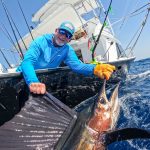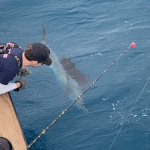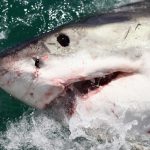Article Courtesy: anglersjournal.com | Originally Published: 8/10/20 | Click here for original article
Frenzy
Photos by Pat Ford
One thing I’ve noticed in my travels is that the best fishing is usually in places that are almost impossible to reach. Magdalena Bay, in Baja, Mexico, is one such place. I’d heard stories for years about the fantastic run of striped marlin that appear in the Pacific off Mag Bay in October and November, but I only recently figured out a way to get there.
A noted breeding and nursery ground for gray whales, the bay is about 550 nautical miles from San Diego and 150 nautical miles from Cabo San Lucas, Mexico, as the crow flies. The main point of access is Puerto San Carlos, a tiny town with only four paved streets, no marina or dockage, and limited gas supplies. It’s an 18-hour drive from San Diego and about six hours from Cabo. All the local boats are pangas, and techniques are basic — some would say rustic — given that Puerto San Carlos is a commercial fishing village. Pangas are launched from beaches, for example, not ramps.
Elite anglers from the West Coast have known about Mag Bay for decades and have kept the place as far off the radar as possible. It can be fished by mega-sportfishing yachts on their way from California to Cabo, but most come up from Cabo, fish for three or four days, then return to Cabo. The only way to refuel in Mag Bay is to have the fuel brought out in a panga. At best, putting questionable local fuel into your multimillion-dollar sportfish is probably not a good idea.
My first opportunity to access Mag Bay came in 2018 when my friend, Eli Martinez of Shark Diver magazine, set up a photography trip. He and five photographers would ride with Magdalena Bay Sport & Adventures’ Capt. Gabino on his pangas to chase bait balls and photograph striped marlin feeding on them. At one point I looked up from the water and saw a white center console with someone casting a fly rod. My first thought was that I had to track down that boat and add some fishing to the following year’s trip.
Enter Joe Zaragoza and Salt Junkies. Zaragoza grew up in California, fished as much as he could and eventually discovered Magdalena Bay. He hooked up with Toby Larocque, who owned MagBay Lures, and they set up a sportfishing operation in San Carlos. They needed a house, boats, a warehouse to store boats, tackle and supplies, and local contacts. They met siblings Kristen and Kurt Meiswinkel, who happened to own a home with an adjoining warehouse and several boats — none of which were being used much. With that, the Lodge at Mag Bay was formed.
The lodge operates a 36-foot ProKat and a 28-foot Cape Horn center console, provides comfortable rooms and excellent meals, and offers offshore and inshore fishing. In 2019, I booked three days with Zaragoza at the lodge. I had never caught a striped marlin on a fly, so that was my main goal. We fished the Cape Horn 28 and found marlin stacked up about 30 miles outside the inlet to Mag Bay, which itself was a 20-mile run from our base. Our first stop was to collect a few dozen mackerel for bait before heading offshore. It wasn’t long before we were cruising over flat-calm water toward the marlin grounds.
The bait and packs of striped marlin seem to concentrate outside the bay on their southern migration during fall. In 2018, they were north of the inlet, but in 2019 they were south, off the tip of Isla Santa Margarita. In calm seas, it took us two hours to reach the hot spot where the sportfishing boats were working. Zaragoza said the bait balls usually appear after 11 a.m. and that until then, we would troll lures. Once we found a bait ball, the plan was to toss out a live bait; Zaragoza guaranteed that every bait we put in the water would be eaten by a marlin.
We trolled MagBay lures and boated several marlin in short order. We then put out hookless lures with the hope of teasing up marlin for the fly rod, which turned out to be more of a chore than expected. We were running twin outboards, and they left quite a wake. The marlin responded aggressively to the lures, but the fly would get lost in the white water off the stern. I finally managed to catch my first stripey on a fly after blowing a dozen chances. That marlin must have jumped 100 times — a great spectacle.
Teasing up marlin became irrelevant around noon when fish began pushing bait balls to the surface. We could spot the bait by the flocks of frigatebirds and pelicans frantically hovering. Zaragoza suggested I try casting the fly into the action from the bow. He’d run the boat up to the frenzy, and I’d cast my 14-weight as far as I could.
That worked for a handful of casts, until my wrist wore out. I didn’t count the number of strikes I had before I finally hooked up, but it was a lot. There always seemed to be a belly in the line, and I couldn’t get the hook to set correctly. I debated going down to a 12-weight, which would have helped my casting, but the feeding marlin ran 60 to 150 pounds, and they would have been a handful on a 12.
I wound up catching four striped marlin on the 14-weight out of more than 20 bites, and a few of those strikes came from fish well over 100 pounds. And every live bait we pitched overboard was eaten seconds after it hit the water. The only glitch was that we had engine trouble on the way in. The lodge has a full-time mechanic, but the part he needed wasn’t in stock, so the next day we were in a 28-foot panga with a live well, rod holders and a sun roof.
Day two was another flat-calm day, with bait balls boiling everywhere. We caught a few more marlin on flies and probably released two dozen fish by day’s end. There were about a half-dozen sportfishing yachts and several pangas loaded with photographers on the grounds. Everyone enjoyed the action without getting in one another’s way. At one point, we were fishing next to Gray Ingram’s 63-foot Scarborough Big Oh and watched his crew catch several marlin, only to learn later that they released 206 that day. Wow!
At the time, my only thought was that Big Oh was on the top of the sportfishing food chain, and our cluttered panga was at the bottom. But it didn’t stop us from having just as much fun. Postscript In 2018, we saw only one or two other pangas a day at Magdalena Bay. In 2019, there were five or six around us most of the time. The word is out about the epic marlin concentrations, but it remains a difficult location to reach and fish, which should keep it special for some time. For more information, go to magbaylodge.com or check out Magdalena Bay Sport & Adventures on Facebook.
Fish After Fish
Anglers aboard the 92-footer Bad Company released 900 striped marlins in four days of fishing
The reports of huge numbers of striped marlin being caught from mega-sportfish yachts off Magdalena Bay in Baja, Mexico, in the Pacific have been astonishing. At times, well more than 200 marlin a day have been caught by a single boat.
Last winter, Anthony Hsieh — founder of consumer lender loanDepot — decided it would be great fun to attempt a world record for the most billfish released in a day. In November, he set up a trip with his 144-foot Trinity Bad Company, which is one of the largest sportfishing yachts in the world, and his other Bad Company, a 92-foot Jones-Goodell. He recruited eight professional anglers and two veterans from the Wounded Warrior Project to accompany him.
The larger Bad Company would act as a mothership and bait tender, while the 92-footer, with Capt. Steve Lassley aboard, would do the fishing. They planned to run up from Cabo San Lucas to Mag Bay, fish for four days, then return. There was an International Game Fish Association representative on board to certify the releases, and a videographer to record the adventure.
The 144-foot yacht was anchored in Mag Bay, and its crew worked at a feverish pace catching mackerel for bait and holding them in live wells for transfer to the 92-footer as needed. The anglers used conventional gear with 30-pound line and pitched live baits to the marlin “SoCal-style” from the bow. They used ultralight-wire circle hooks and 2 to 3 feet of Aftco Saiko Pro fluorocarbon leader attached with double uni knots to the 30-pound line. The light-wire hooks and short leaders were designed to have the least amount of impact on the fish.
IGFA allows 30 feet of leader in the 30-pound class, so the plan was to get each marlin within 30 feet of the boat and then break it off. As it turned out, every line broke at the leader knot. Four crewmembers rerigged the rods as fish were released. All releases were certified. The striped marlin averaged 50 to 150 pounds.
On Nov. 6, 2019, Bad Company released 330 marlin during its first day off the bay. The crew’s technique was to have the professional anglers make their hookups from the bow: One would get on point, hook up, then move back and to the side as the next in line moved into the point, hooked up, moved back and to the side, and so on. The two vets fished from the stern and at one point had 13 marlin hooked up at the same time.
Few strikes were missed. This feat is even more impressive when you learn that the anglers ran out of bait and had to take two hours of fishing time to run back to the mothership to reload. They started with 1,000 prerigged leaders, used more than 3,000 live baits and released 900 striped marlin during the four-day trip. The veterans and crew (not the pro anglers) caught 96 marlin.
There were also plenty of fish hooked and lost or broken off outside the 30-foot range needed to qualify as an official IGFA release. The crew used about 1,100 baits to release the 330 marlin in seven hours. To give those numbers some context, that’s a release about every 77 seconds.
Never Gets Old
Pat Ford says photographing striped marlin feeding on pods of bait may be more fun than hooking them
My first visit to Magdalena Bay was with Shark Diver magazine two years ago. It was strictly a photography expedition, and I didn’t know what to expect.
We ran offshore in a local panga, spotted frigates circling, ran up on them and jumped overboard. It’s hard to convey what it’s like being in the water when several marlin and a few sea lions are attacking a bait ball. Nothing I’ve ever seen compares to a lit-up striped marlin chasing bait 30 feet in front of my face. The bait clusters comprise anywhere from a few dozen to a few thousand sardines or mackerel. I was so impressed I returned to Mag Bay last fall.
In the morning, when the bait is running, it’s difficult to keep up with the action, so taking shots is tough. The bait becomes less active in the afternoon.
When there were a few divers in the water, the sardines and mackerel sometimes swam right at us, essentially trying to use us for cover. There could be up to a dozen marlin working a static ball, along with a half-dozen sea lions, which would occasionally try to chase off the marlin and us. A 400-pound sea lion hovering in the water a few feet from you, chomping its teeth and blowing bubbles, gets your attention. We repeatedly had to swim away from the school to give the marlin an opportunity to feed.
The marlin often were too close to the camera to capture in a decent photo. At one point I was floating next to the bait when a marlin attacked and stunned a mackerel, which spun away from the school. As I watched, two marlin fought over the injured fish, until one was able to catch it. This happened within 20 feet of me in water as clear as glass. Marlin constantly swam within a few feet of us, unconcerned by our presence.
The bait balls were usually so thick that we couldn’t see what was on the other side, nor could the marlin see us. Several times the bait ball rushed at me and then split, leaving me face to face with a charging marlin. The billfish maintained good control and didn’t injure any of us, but it was a quite a rush. You had to be careful whenever you were in the water.
Photographing striped marlin feeding on tight clusters of sardines and mackerel never ever gets old. One day we spent almost five hours in the water, and we could hardly wait to get back out the next morning. Every dive is different. It’s tiring, so you have to be in pretty good shape, but the rewards far exceed the pain. (Climbing in and out of the panga is the worst part.) Next year I might even leave the fishing rods home.











